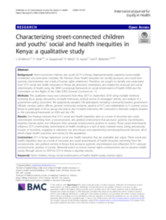Abstract
Background: Street-connected children and youth (SCY) in Kenya disproportionately experience preventable morbidities and premature mortality. We theorize these health inequities are socially produced and result from systemic discrimination and a lack of human rights attainment. Therefore, we sought to identify and understand how SCY’s social and health inequities in Kenya are produced, maintained, and shaped by structural and social determinants of health using the WHO conceptual framework on social determinants of health (SDH) and the Convention on the Rights of the Child (CRC) General Comment no. 17.
Methods: This qualitative study was conducted from May 2017 to September 2018 using multiple methods including focus group discussions, in-depth interviews, archival review of newspaper articles, and analysis of a government policy document. We purposively sampled 100 participants including community leaders, government officials, vendors, police officers, general community residents, parents of SCY, and stakeholders in 5 counties across Kenya to participate in focus group discussions and in-depth interviews. We conducted a thematic analysis situated in the conceptual framework on SDH and the CRC.
Results: Our findings indicate that SCY’s social and health disparities arise as a result of structural and social determinants stemming from a socioeconomic and political environment that produces systemic discrimination, breaches human rights, and influences their unequal socioeconomic position in society. These social determinants influence SCY’s intermediary determinants of health resulting in a lack of basic material needs, being precariously housed or homeless, engaging in substance use and misuse, and experiencing several psychosocial stressors, all of which shape health outcomes and equity for this population.
Conclusions: SCY in Kenya experience social and health inequities that are avoidable and unjust. These social and health disparities arise as a result of structural and social determinants of health inequities stemming from the socioeconomic and political context in Kenya that produces systemic discrimination and influences SCYs’ unequal socioeconomic position in society. Remedial action to reverse human rights contraventions and to advance health equity through action on SDH for SCY in Kenya is urgently needed.

